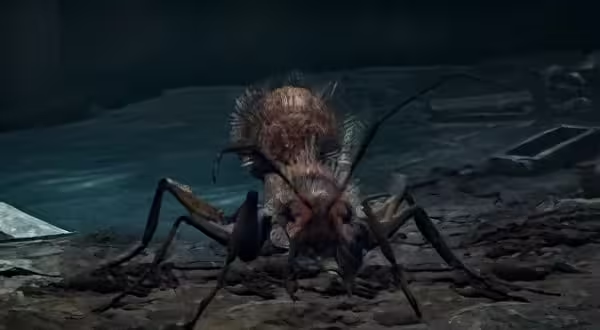
Giant Ant
| Location | |
| Ainsel RiverDungeon | |
| Deeproot DepthsGrace | |
| Miquella's HaligtreeDungeon | |
| Nokstella, Eternal CityGrace | |
Drops | |
| Formic Rock | 0.08 |
| Numen's Rune | |
| Rune Arc | 0.01 |
| Runes | |
| 122 | |
| Description | |
Bloated Ants (queens)
Bloated Ants
Bloated Ants only
Appearance
Subtype
Notes
Damage type
Resistance
Standard
Guard bypass rate
That order
If one decides to use bleed weapons on the Giant Ants, they should keep in mind the Giant Ants are strongest against Slash-type physical damage (see the table below). | |
| Notes | |
Each ant has different meshes for their abdomen, meaning that some ants are functionally the same, but can look slightly different.
The mesh for the Bloated Ant is called Honey, further signifying the resemblance.
Ants are easily staggered, even by small amounts of damage such as stepping into fire created by a Steel-Wire Torch or magic.
Giant Ants are weak to fire and resist slash-type damage.
The spray attack deals Standard physical damage, but has a special 'Guard bypass rate' of -60. This means the spray attack will damage you while guarding, even with a shield at 100 physical resistance.
This means you want to avoid being hit by the spray in the first place.
Strafing or rolling are better options than guarding, even for shield users.
The attack can also hit you multiple times and can easily drain through your health if you're not careful.
When you get closer to Giant Ants, they will prioritize biting attacks.
If you get even closer, you're in danger of getting grabbed (a special grapple attack where the ant will grab the player, raise them up high, and stab them with their stinger before slamming them on the ground).
Due to the fact that they drop Formic Rocks, it seems to be implied that the acid spray is indeed formic acid, the same acid deployed by real ants.
The spurs (stingers) on the ants do not cause Scarlet Rot, unlike the Antspur Rapier, which is an ant's spur that has been modified and augmented by a scarlet rot fanatic, Maleigh Marais.
Some Worker Ants are mounted by a Nox Swordstress.
They can be encountered in the upper region of Nokstella, Eternal CityGrace.
They have glowing purple eyes, which are believed to be caused by a sort of mind control utilized by the Nox to subdue the ant.
If the player successfully initiates the Sleep Status Effect on the mounted Ant, it will eject the Nox rider from its back and proceed to attack her.
One should note that the Nox Swordstress is a somewhat stronger enemy and that it might pay off to stagger/damage the Nox to help the ant kill her.
These ants will also attack Silver Tears in their vicinity if they survive.
The Giant Ants in question have a Sleep threshold of between 130 to 140, a considerably low value.
This means that it should be possible for any character to proc Sleep on them.
A sleep pot will be overkill and you should be able to proc sleep with 2-3 sleepbone arrows instead.
The Pulley Crossbow with sleepbone bolts is another good alternative due to its 3-shot burst, but be aware of recoil.
Giant ants are susceptible to status ailments Sleep, Frostbite, Blood , and Scarlet Rot/Poison, in that order.
(Weakest to sleep and stronger against rot or poison).
However, they are immune to Madness and Death Blight.
If one decides to use bleed weapons on the Giant Ants, they should keep in mind the Giant Ants are strongest against Slash-type physical damage (see the table below).
The various ant subtypes are references to references to different castes and species.
Winged Ants are alates, mature ants that grow wings to fly off and find mates to begin new colonies.
Shield-Headed Ants are likely phragmotic ants based on Turtle Ant soldiers, as they use their large and flat head to block colony entrances from invaders
Bloated Ants are based on Honeypot Ant repletes, who store honey and sugar in their abdomens for the colony to use.
The mesh for their bloated body is named Honey to prove this. |
